Module1Unit1第1课时教案
- 格式:doc
- 大小:27.50 KB
- 文档页数:5

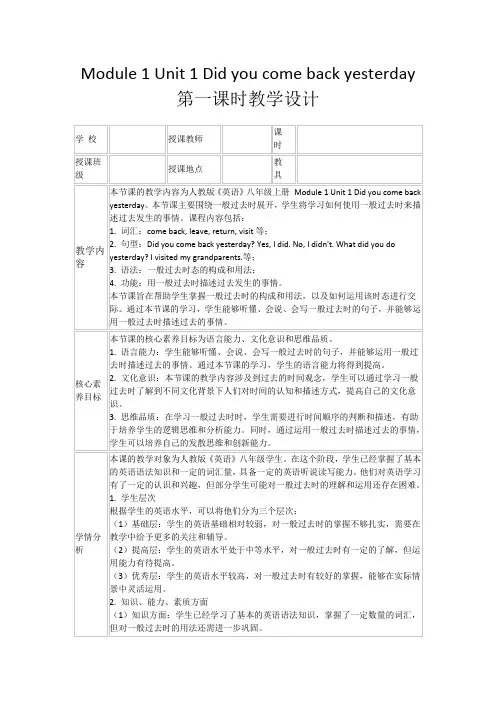
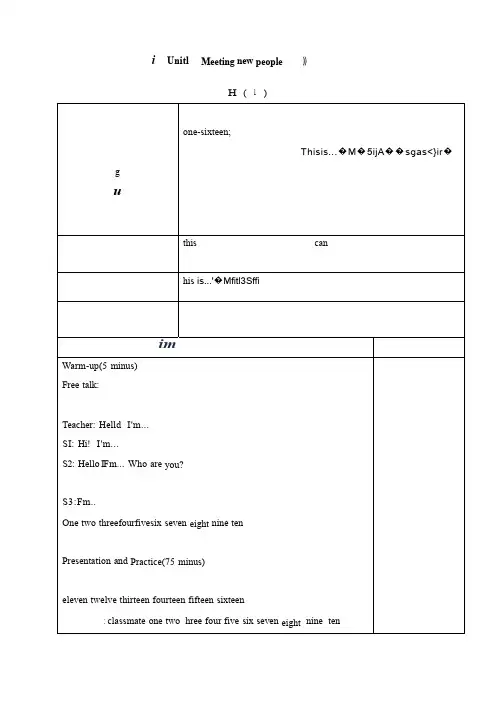
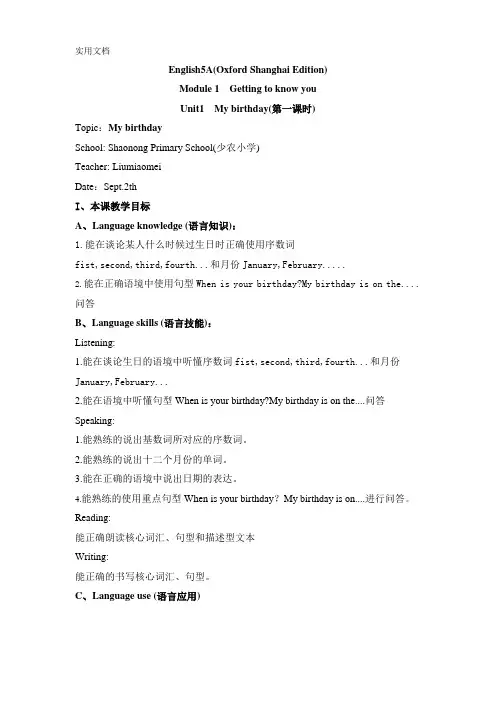
English5A(Oxford Shanghai Edition)Module1 Getting to know youUnit1 My birthday(第一课时)Topic:My birthdaySchool: Shaonong Primary School(少农小学)Teacher: LiumiaomeiDate:Sept.2thI、本课教学目标A、Language knowledge (语言知识):1.能在谈论某人什么时候过生日时正确使用序数词fist,second,third,fourth...和月份January,February.....2.能在正确语境中使用句型When is your birthday?My birthday is on the....问答B、Language skills (语言技能):Listening:1.能在谈论生日的语境中听懂序数词fist,second,third,fourth...和月份January,February...2.能在语境中听懂句型When is your birthday?My birthday is on the....问答Speaking:1.能熟练的说出基数词所对应的序数词。
2.能熟练的说出十二个月份的单词。
3.能在正确的语境中说出日期的表达。
4.能熟练的使用重点句型When is your birthday?My birthday is on....进行问答。
Reading:能正确朗读核心词汇、句型和描述型文本Writing:能正确的书写核心词汇、句型。
C、Language use (语言应用)培养学生在正确的语境中用句型When is your birthday?询问他人的生日以及用句型My birthday is on the....回答。
D、Cultural consciousness (文化意识):通过生日party了解国外的文化“主题派对”E、Affection and attitudes (情感态度)通过学习主题派对了解生日还可以过的如此生动有趣从而引发对自己生日的期待。
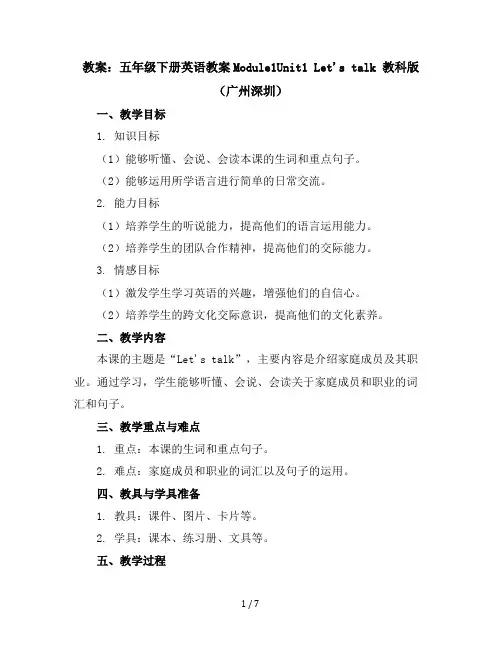
教案:五年级下册英语教案Module1Unit1 Let's talk 教科版(广州深圳)一、教学目标1. 知识目标(1)能够听懂、会说、会读本课的生词和重点句子。
(2)能够运用所学语言进行简单的日常交流。
2. 能力目标(1)培养学生的听说能力,提高他们的语言运用能力。
(2)培养学生的团队合作精神,提高他们的交际能力。
3. 情感目标(1)激发学生学习英语的兴趣,增强他们的自信心。
(2)培养学生的跨文化交际意识,提高他们的文化素养。
二、教学内容本课的主题是“Let's talk”,主要内容是介绍家庭成员及其职业。
通过学习,学生能够听懂、会说、会读关于家庭成员和职业的词汇和句子。
三、教学重点与难点1. 重点:本课的生词和重点句子。
2. 难点:家庭成员和职业的词汇以及句子的运用。
四、教具与学具准备1. 教具:课件、图片、卡片等。
2. 学具:课本、练习册、文具等。
五、教学过程1. 热身(5分钟)(1)与学生进行简单的英语对话,检查他们的英语水平。
(2)引导学生复习上节课学过的内容,为新课的学习做好铺垫。
2. 引入(10分钟)(1)通过课件展示本课的主题,引起学生的兴趣。
(2)向学生介绍本课的学习目标,让他们明确学习任务。
3. 呈现(10分钟)(1)通过课件、图片、卡片等教具,呈现本课的生词和句子。
(2)让学生听懂、会说、会读本课的生词和句子。
4. 操练(10分钟)(1)分组进行角色扮演,让学生运用所学语言进行交流。
(2)组织学生进行小组活动,让他们在实践中掌握所学知识。
5. 巩固(10分钟)(1)通过课件、图片、卡片等教具,让学生复习本课的知识。
(2)设计一些练习题,让学生巩固所学内容。
6. 拓展(5分钟)(1)让学生运用所学知识,进行一些实际操作。
(2)引导学生进行一些创新性的思考,提高他们的语言运用能力。
(2)鼓励学生课后继续学习,提高他们的英语水平。
六、板书设计1. 板书主题:Module1Unit1 Let's talk2. 板书生词:family members, father, mother, brother, sister, doctor, teacher, engineer3. 板书句子:Hello, I'm This is my He/She is my七、作业设计1. 抄写本课的生词和句子,每个单词和句子写两遍。
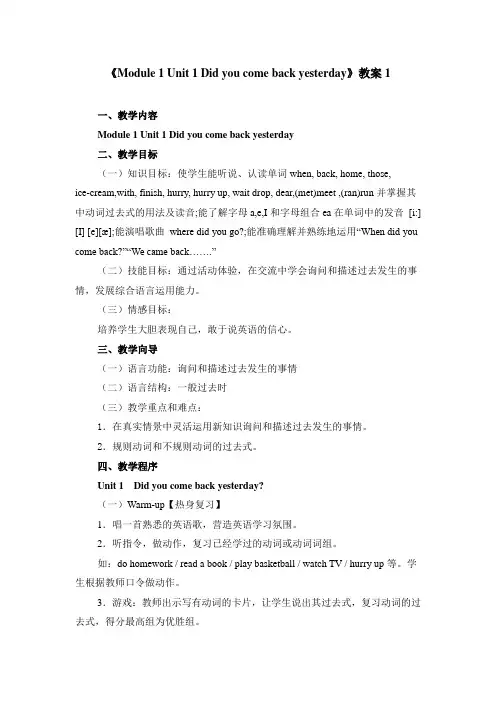
《Module 1 Unit 1 Did you come back yesterday》教案1一、教学内容Module 1 Unit 1 Did you come back yesterday二、教学目标(一)知识目标:使学生能听说、认读单词when, back, home, those,ice-cream,with, finish, hurry, hurry up, wait drop, dear,(met)meet ,(ran)run并掌握其中动词过去式的用法及读音;能了解字母a,e,I和字母组合ea在单词中的发音[i:] [I] [e][æ];能演唱歌曲where did you go?;能准确理解并熟练地运用“When did you come back?”“We came back…….”(二)技能目标:通过活动体验,在交流中学会询问和描述过去发生的事情,发展综合语言运用能力。
(三)情感目标:培养学生大胆表现自己,敢于说英语的信心。
三、教学向导(一)语言功能:询问和描述过去发生的事情(二)语言结构:一般过去时(三)教学重点和难点:1.在真实情景中灵活运用新知识询问和描述过去发生的事情。
2.规则动词和不规则动词的过去式。
四、教学程序Unit 1 Did you come back yesterday?(一)Warm-up【热身复习】1.唱一首熟悉的英语歌,营造英语学习氛围。
2.听指令,做动作,复习已经学过的动词或动词词组。
如:do homework / read a book / play basketball / watch TV / hurry up等。
学生根据教师口令做动作。
3.游戏:教师出示写有动词的卡片,让学生说出其过去式,复习动词的过去式,得分最高组为优胜组。
如:play – played, go-went, come-came, do-did, buy-bought, drop-dropped. 同时学习本课生词。
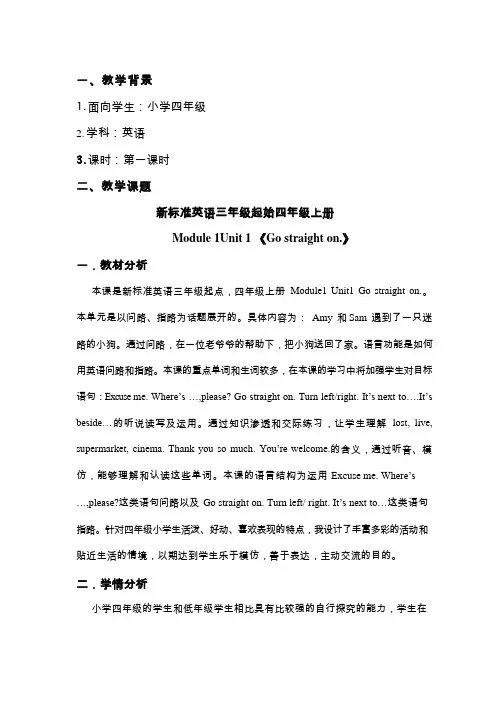
一、教学背景1.面向学生:小学四年级2.学科:英语3.课时:第一课时二、教学课题一.教材分析新标准英语三年级起始四年级上册Module 1Unit 1 《Go straight on.》本课是新标准英语三年级起点,四年级上册Module1 Unit1 Go straight on.。
本单元是以问路、指路为话题展开的。
具体内容为:Amy 和Sam 遇到了一只迷路的小狗。
通过问路,在一位老爷爷的帮助下,把小狗送回了家。
语言功能是如何用英语问路和指路。
本课的重点单词和生词较多,在本课的学习中将加强学生对目标语句:Excuse me. Where’s …,please? Go straight on. Turn left/right. It’s next to….It’s beside…的听说读写及运用。
通过知识渗透和交际练习,让学生理解lost, live, supermarket, cinema. Thank you so much. You’re welcome.的含义,通过听音、模仿,能够理解和认读这些单词。
本课的语言结构为运用Excuse me. Where’s …,please?这类语句问路以及Go straight on. Turn left/ right. It’s next to…这类语句指路。
针对四年级小学生活泼、好动、喜欢表现的特点,我设计了丰富多彩的活动和贴近生活的情境,以期达到学生乐于模仿,善于表达,主动交流的目的。
二.学情分析小学四年级的学生和低年级学生相比具有比较强的自行探究的能力,学生在观察能力、思维能力、语言表达能力方面都有了较好的提高,有着强烈的好奇心与动手操作的能力。
他们喜欢在自己的探索中获取知识,喜欢在玩中学,喜欢在做中学,喜欢在想中学,喜欢在用中学。
对周边的事物产生着浓厚的兴趣,有着强烈的学习愿望,但不能自觉地从生活中进行学习,所以,在学习的方式上,教师需要及时地引导,使学生将所学运用与生活实际。
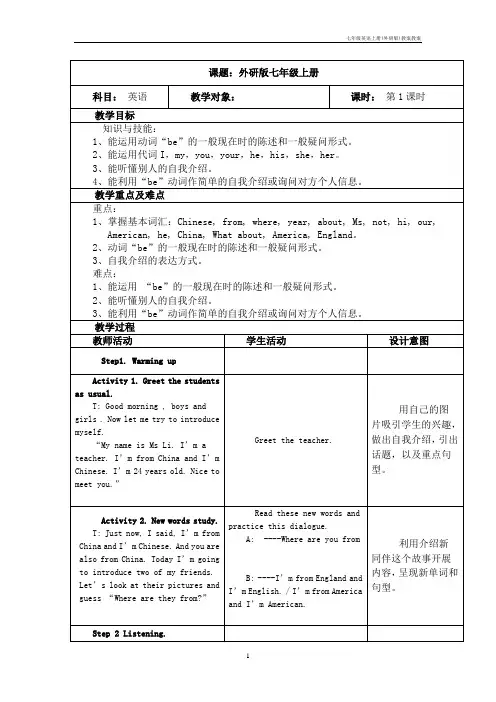

Module1 第1课时教案一、教学内容外研版小学英语五年级上册第一模块第1课时Unit 1 Activities 1—2。
二、教学目标1. 能够听、说、认、读单词和词组ground, above, finish, hurry up.2. 能够听、说、读、写单词met, those.3. 能够听懂问句Did you come back yesterday?并能做出正确的回答Yes, I/we did. No, I/we didn’t.4. 能够运用所学的语言知识和同伴进行问答。
三、教学重难点重点:听、说、读、写单词和短语met, ground, above, finish, those, hurry up.难点:记忆不规则动词的过去式。
四、教学准备1. 单词卡片(“Module1 Unit1单词卡片集”直接使用)。
2. 音频(使用)。
3. 人物头饰。
4. PPT课件。
五、教学设计Step 1 Warm-upLet’s chant1. 教师边播放自己去年去伦敦的幻灯片,边描述:I went to London last year. I met a friend. I visited the London Eye. I saw many beautiful flowers. 接着让学生猜测wen, met, visited, saw 的意思,并适当讲解。
再播放书中第一部分的图片,引出主人公玲玲也去了伦敦这个话题,从而引出chant的内容:Lingling went to London Town.She met John, a little boy.They visited the London Eye and saw the city from above the ground.2. 教师边放录音,边做动作,同时让学生理解课文插图的意思。
3. 学生跟着录音边听边唱,最后再说唱。
4. 教师也可以在电脑上播放动画,同时展示chant内容,让学生边听、边看、边说唱。
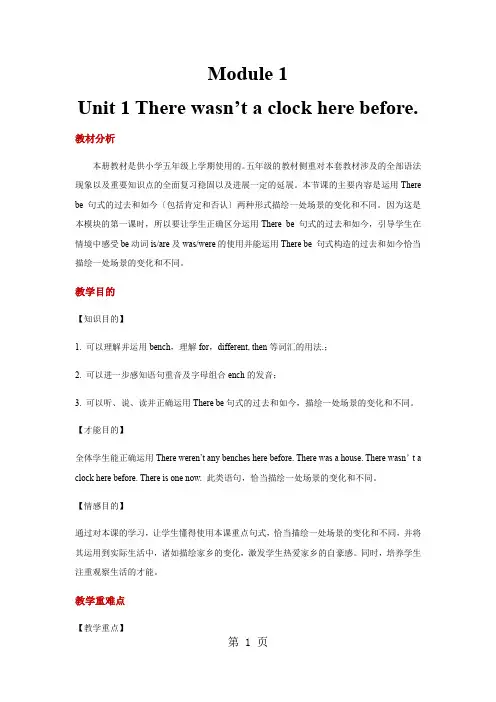
Module 1Unit 1 There wasn’t a clock here before.教材分析本册教材是供小学五年级上学期使用的。
五年级的教材侧重对本套教材涉及的全部语法现象以及重要知识点的全面复习稳固以及进展一定的延展。
本节课的主要内容是运用There be 句式的过去和如今〔包括肯定和否认〕两种形式描绘一处场景的变化和不同。
因为这是本模块的第一课时,所以要让学生正确区分运用There be 句式的过去和如今,引导学生在情境中感受be动词is/are及was/were的使用并能运用There be 句式构造的过去和如今恰当描绘一处场景的变化和不同。
教学目的【知识目的】1. 可以理解并运用bench,理解for,different, then等词汇的用法.;2. 可以进一步感知语句重音及字母组合ench的发音;3. 可以听、说、读并正确运用There be句式的过去和如今,描绘一处场景的变化和不同。
【才能目的】全体学生能正确运用There weren’t any benches here before. There was a house. There wasn’t a clock here before. There is one now. 此类语句,恰当描绘一处场景的变化和不同。
【情感目的】通过对本课的学习,让学生懂得使用本课重点句式,恰当描绘一处场景的变化和不同,并将其运用到实际生活中,诸如描绘家乡的变化,激发学生热爱家乡的自豪感。
同时,培养学生注重观察生活的才能。
教学重难点【教学重点】1.学习、理解词汇bench,理解for, different, then;2. 纯熟、灵敏运用目的语句There weren’t any benches here before. There was a house. There wasn’t a clock here before. There is one now. 描绘一处场景的变化和不同。
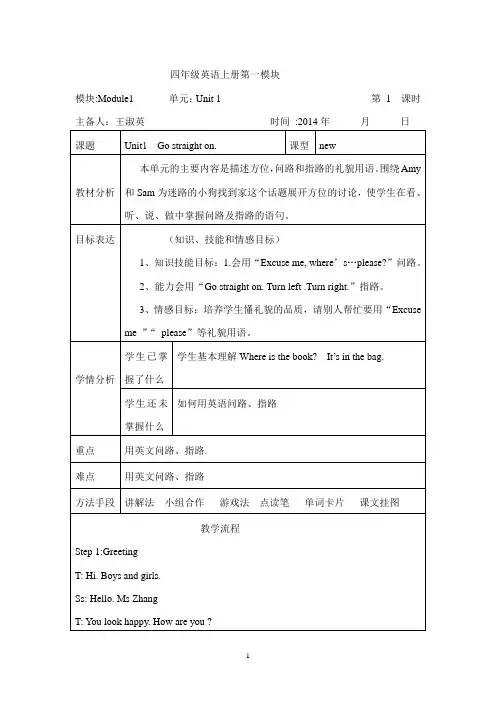
四年级英语上册第一模块模块:Module1 单元:Unit 1 第 1 课时主备人:王淑英时间:2014年______月______日课题Unit1 Go straight on. 课型new教材分析本单元的主要内容是描述方位,问路和指路的礼貌用语。
围绕Amy 和Sam为迷路的小狗找到家这个话题展开方位的讨论,使学生在看、听、说、做中掌握问路及指路的语句。
目标表达(知识、技能和情感目标)1、知识技能目标:1.会用“Excuse me, where’s…please?”问路。
2、能力会用“Go straight on. Turn left .Turn right.”指路。
3、情感目标:培养学生懂礼貌的品质,请别人帮忙要用“Excuseme ”“please”等礼貌用语。
学情分析学生已掌握了什么学生基本理解Where is the book? It’s in the bag.学生还未掌握什么如何用英语问路、指路重点用英文问路、指路.难点用英文问路、指路方法手段讲解法小组合作游戏法点读笔单词卡片课文挂图教学流程Step 1:GreetingT: Hi. Boys and girls.Ss: Hello. Ms ZhangT: You look happy. How are you ?Ss: Very well. Thank you .And you?T: I’m very well.Step 2:WarmerT: Boys and girls.Do you like dancing? Good. Stand up , please. Follow the music , let’s dance .教师在前面示范。
Left. Right. Go. Turn around .Go go go.Left. Right. Go. Turn around .Go go go.Step 3:Presentation1、T talk to S1T: Excuse me,give me a pencil-box,please?S1 Pass a pencil-box to T.2、T pretend to drop the pencil-box.T:The pencil-box is lost .Where’s my pencil-box ?(Ss point to it)3、T:Oh .Go straight on. Turn left .It’s here. Thank you.4、T: Boys and girls ,now, we’re learning directions.板书Module 2 DirectionsGo straight on(画图标). Turn left(画图标) .Turn right(画图标).Step 4:Learning and practice1、Act and say: Go straight on. Turn left .Turn right.T:(Turn right)Ss: Turn right.T : ( Go straight on)Ss: Go straight on.2、Read the three sentences.3、Contest: listen and act每大组派一名成员上台,教师发出口令,用上刚才学过的句子。
三年级上册英语教案-module1Unit 1外研社(一起)一、教学目标1. 知识目标1.学习认读26个小写字母和3个大写字母;2.能用正确的发音念出26个字母的名称;3.能听懂、会应答日常交际用语。
4.复习并掌握问候语。
2. 能力目标1.训练学生听、说、读英语的能力,培养其初步的英语交际能力;2.培养学生的观察能力,注意力和快速反应能力;3.通过听说读的方式培养和提高学生的英语综合语言运用能力。
3. 情感目标1.培养学生对英语的兴趣;2.发扬团结合作精神,促进同学之间的交往和帮助,在积极向上的课堂氛围中学习。
二、教学重点1.认读26个小写字母和3个大写字母;2.能用正确的发音念出26个字母的名称;3.能听懂、会应答日常交际用语。
三、教学难点1.能听懂、会应答日常交际用语。
四、教学准备1.教师准备课桌和黑板;2.视频或课件;3.口语表和物品。
1. 创设情境,导入新课1.利用视频和课件,让学生熟悉26个字母,掌握它们的发音和写法,并有些许练习。
2. 学习新课A. 学习单词:1.apple2.boy3.car4.dogB. 听力练习:1.根据老师的描述,学生回答问题,如What’s this? It’s an apple.C. 复习问候语1.Good morning/afternoon/evening2.How are you?3.(I’m)Fine, thank you. / Not good.D. 练习问答句子1.例子:•A: Good morning.•B: Good morning.2.见到陌生人询问姓名,如:•A: What’s your name?•B: My name is Mike.3. 小结1.复习26个字母,会写出字母的名称,并掌握它们的发音;2.认识4个单词,并能听懂和说出这些单词;3.能听懂、会应答日常交际用语。
本节课教学模式较为单一,主要以听说为主,评价标准也较简单明确。
在教学中,同桌认读英文字母时部分学生认读困难。
外研版(一起)一年级英语上册《Module 1 Unit 1》教案设计教学目标1.能够听懂、说出本单元的四个单词:book, pen, pencil, eraser。
2.能够在语境中自然流畅地运用单词:book, pen, pencil, eraser。
3.能够听懂并模仿老师口头指令:Read, Write, Draw。
4.能够听懂并做出正确反应:Raise your hand, Stand up, Sit down。
5.能够模仿并跟读教材中的简短句子。
教学重难点1.重点:四个单词的掌握和运用。
2.难点:新出单词与现有单词的识别和区分。
教学准备1.课件。
2.单词卡片或翻牌。
3.学生练习册。
教学步骤Step 1 导入1.教师利用PPT或黑板上写出四个单词:book, pen, pencil, eraser。
2.让学生逐个读出单词。
Step 2 新词教学1.教师利用PPT或黑板演示单词,并发音示范。
2.让学生跟着发音练习。
3.教师随机出示单词卡片或翻牌,让学生口头识别单词。
Step 3 情境教学1.教师以“在图书馆”为情境,出示图片或PPT。
2.教师用句子“See the book. See the pen. See the pencil. See the eraser.”进行语音示范。
3.让学生模仿句子并动作模拟。
Step 4 口头指令及反应训练1.教师用句子“Read the book. Write with the pen. Draw with the pencil. Erase with the eraser.”进行语音示范。
2.让学生模仿句子,并根据口头指令动作模拟。
Step 5 练习册1.教师让学生翻开练习册第一单元,根据图片和单词在练习册中完成填空。
2.教师进行点评和纠正。
课堂反思通过这节课的教学,学生对新单词的学习达到了预期效果,同时也有效培养了学生的听说能力。
教学过程中,需要注意与学生的互动,使学生更好地参与其中,提高学生的学习兴趣。
Module1 Feelings and impressionsUnit1 It smells delicious.Teaching Content: Listening and Vocabulary and Pronunciation and SpeakingTeaching Aims and Demands:1. Language Knowledgefresh, cookie, try, lovely, done, pie, forKey structure: link verbs + adj.2. Listening skill: To listen to the conversation and understandsentences with senseverbs.3. Speaking skill: To describe things and persons with sense verbs.4. Attitudes: We should help and care for each other.Teaching key and difficult points:Learning strategies:Bottom –up approach and listening to the tape and do some eulti-Media (Tape recorder, video, OHP, handout)Teaching Procedures:Step 1: Warming up1.Listen to a song Heads and shoulders2.Listen and do: Listen to the teacher’s order and do the action,Eg: Touch your nose. Put up your hands.Step2: Presentation1. Show some fruit and cookie, etc to the students and ask them to do look, sound, smell, taste, feel, then ask: Do you like…? How does it/ do they …? Make the students use some adjectives to describe the things like this: They are delicious. It is lovely. The teacher will say: “Yes. They taste delicious. It looks lovely. ”Learn the new words and key structures in this way.2. Pair work1) Work in pairs like this:A: Do you like flowers?B: Yes, I do. They look nice. Do you like cheese?……Practise the key structures.2) Ask some group to make a dialogue in the class. Other studentswrite down the key sentences they make and conclude the rule of sense verbs, like this:[中*&%@国教育~出版网]It smells too strong and it tastes a bit sour. They taste really sweet and they feel soft in the middle.Conclude the rule: sense verbs+/adj./ , i.e.: look, sound,smell, feel, taste+ adj.3.Pronunciation and speaking1)Listen and underline the words the speaker stresses.Step3: Practice1. Listen to the tape and finish Activity1 in the tee students to read the sentences in Activity2 and check the answers.[中~国%&*教育出^版网]3. Listening to the tape of Activity3 and try to answer:a. What does the pizza look like?b. How does the pizza taste?[w#ww.zz%s~@tep^.com]c. What smells delicious?d. What doesn’t smell fresh?e. How does the chocolate cookies taste and feel?4. Listen to the tape and repeat.5. Read the dialogue in roles.6. Game: Catch the thief.7. Fill in the blanks with different sense verbs.1) The pizza ______ sour. 2) The sugar ______ sweet.3) The boy ______ strong. 4) The silk ______ soft.5) The song ______ good.[中国教*育&@^#出版网]Step4: Consolidation1.Finish Activity 4 and 5.2.Finish some ee students to conclude the key point in this lesson. Step5: Homework1.Act out the dialogue in group of 4.2.Copy the new words for 5 times each.3.Preview Unit2Reflections:[来#源:%中^教@网&]1.重点词句在教学过程中的体现不够;2.系表结构句子的归纳欠缺;3.课外练习筛选应补上;4.多做点五个感官动词+adj. 的句型练习。
Module1 Unit 1教案(一)Unit 1 I t’s more than 2,000 years old.教案(二)Ⅰ Teaching modelListening and speakingⅡ Teaching methodTop-down approachⅢ Teaching aims1. To learn and understand the topic words through talking and listening;2. To know something about The Terracotta Army, The Three Gorges Dam, TheGiant’s Causeway an d Victoria Falls;3. To understand conversations involving different tenses.Ⅳ Teaching Objectives1. Key vocabulary: man-made, natural, wonder, discussion, eastern, though, loud,wow, opinion, in one’s opinion, more than, electricity, millions of 2. Key structures: Sentence structureⅤ Teaching aidsTape r ecorder, OHP , videoⅥ Teaching StepsStep 1 Warming-up1. Show some pictures of the wonders of the world.2. Enjoy and talk something about the pictures.3. Show some pictures to introduce the new words.4. Learn the new words.5. Read the words after the teacher.Step 2 Match the name.Match the names of the wonders with the pictures.1. Ask t he students to look at the pictures.2. Read through the names of the wonders.a) The Terracotta Army b) The Three Gorges Damc) The Giant’s Causeway d) Victoria Falls3. Match the names of the wonders with the pictures.4. Ask the students to check their answer with a partner.5. Call back the answers from the whole class and check the answers.Step 3 Answer the questions.Look at the pictures and answer the questions. Use the words in the box to help you.1. Ask the students to look at the pictures in Activity1.2. Ask the students to read through the words in the box.ancient man-made modern natural wonder3. Ask the students to read through the questions in Activity 2.1) Which two are natural wonders?2) Which two are man-made wonders?3) Which is an ancient wonder?4) Which is a modern wonder?4. Look at the pictures and answer the questions. Use the words in the box to help you.5. Ask the students to check their answer with a partner.6. Call back the answers from the whole class and check the answers.7. Now listen and check.Step 4 Listen and read.1. Ask the students to listen and read the conversation silently.2. Check(√)the true sentences.1) Tony thinks the Giant’s Causeway is the largest natural wonder.2) Lingling thinks Victoria Falls is more fantastic than the Giant’s Causeway.3) Betty and Daming are more interested in man-made wonders.4) For Daming, the Three Gorges Dam is more fantastic than the Terracotta Army.3. Ask the students to read the passage and finish Activity4.1) Where is the Giant’s Causeway?2) How wide is Victoria Falls?3) What wonders does Betty think are more exciting?4) How old is the Terracotta Army?4. After Reading: Complete the table.Step 5 Pronunciation and speaking: Listen and mark the pauses.1. Play the recording once without stopping.2. Play the recording again and ask the whole class to repeat.1) I’ve never seen it, so I’m not sure I agree with you.2) That sounds great, though I think Victoria Falls in Africa is even more fantastic.3) In my opinion, man-made wonders are more exciting than natural ones.3. Ask the students to listen and mark the pauses.4. Now listen again and repeat.Step 6 Language points1. Let’s call Wonder of the World and join in the discussion.我们给《世界奇观》节目打电话,加入讨论吧。
教案:Module 1 Unit 1 It's the ABC song一、教学目标1. 知识目标(1)能够听懂、会说、会读本课核心单词:letter, a, b, c, d, e, f, g。
(2)能够听懂、会说、会读句子:It's the ABC song. 和It'sa letter.(3)能够听懂、会唱ABC song。
2. 能力目标(1)能够正确书写字母ag。
(2)能够用所学单词和句子进行简单交流。
3. 情感目标培养学生的学习兴趣,激发学生学习英语的积极性。
二、教学内容1. 核心单词:letter, a, b, c, d, e, f, g。
2. 核心句子:It's the ABC song. 和It's a letter.3. 歌曲:ABC song。
三、教学重点与难点1. 重点:能够听懂、会说、会读单词letter, a, b, c, d, e, f, g和句子It's the ABC song. 和It's a letter.2. 难点:能够正确书写字母ag。
四、教具与学具准备1. 教具:PPT,字母卡片,字母模具。
2. 学具:练习本,铅笔,橡皮。
五、教学过程1. 热身(5分钟)(1)教师与学生用中文进行简单的交流,询问学生的情况。
(2)教师播放英语歌曲,引导学生跟唱。
2. 引入(10分钟)(1)教师出示字母卡片,引导学生说出字母名称。
(2)教师用PPT展示字母ag的图片,引导学生说出字母名称。
3. 呈现(15分钟)(1)教师出示句子It's the ABC song. 和It's a letter. ,引导学生理解句子意思。
(2)教师引导学生跟读句子。
4. 操练(10分钟)(1)教师分组,每组选出一个字母,组内成员轮流说句子It's a letter.(2)教师播放ABC song,引导学生跟唱。
5. 书写(5分钟)(1)教师出示字母模具,引导学生正确书写字母ag。
Module1 Unit1 第1课时教案一、教学内容外研版小学英语六年级上册第一模块第一单元第一课时: Unit 1 1. Listen and chant. 2. Listen, read and act out.二、教学目标1. 大多数学生能够听、说、读、写单词或短语: more than, thousand, kilometre, something, million.2. 大多数学生能够听懂并运用句型: These postcards are great! It’s a picture of the Great Wall. Tell me more about... It’s...谈论某个地方或某个事物的情况。
3. 能够运用所学的语言知识与同伴进行交流。
三、教学重难点(一)重点:1. 听、说、读、写单词和短语more than, thousand, kilometer, something, million.2. 学习句型: These postcards are great! It's a picture of the Great Wall. Tell me more ab out... It’s...(二)难点:1. 运用句型: These postcards are great! It’s a picture of the Great Wall. Tell me more about…It’s…谈论某个地方或某个事物的情况。
2. thousand, million的用法。
四、教学准备1. 单词卡片(可从优教平台下载“Module1 Unit1单词卡片集”直接使用)。
2. 音频(可从优教平台下载使用)。
3. 人物大明和西蒙的头饰。
4. PPT课件。
5. 学生假期的照片。
五、教学设计Step 1 Warm-up1. Free talk.老师热情地问候学生们,欢迎他们在暑假过后回到学校。
老师先通过PPT课件展示自己暑假去北京的照片,并用英语说: I went to Beijing on the summer holiday.I took some pictures. Look at the pictures on the screen. It’s a picture of the Great Wall. It’s very beautiful.然后用英语询问学生们:Where did you go on your holiday?What did you do on your holiday?Did you have anything interesting?OK! Please take out your pictures, and tell us something about your pictures. Use the drill: It’s a picture of...It’s very...【设计思路】从学生感兴趣的话题入手,激发学生的学习积极性,拉近师生间的距离。
让学生快速地进入学习状态。
2. Let’s chant.PPT课件出示长城的图片,告诉学生:It’s a picture of the Great Wall. It’s very beautiful. It’s long and old. There is a chant about our Great Wall. Look at Page 2 Activity 1 Listen and chant.At first, let the students listen to the tape and follow it twice. Then the students clap their hands and say the chant together. At last let the students clap their hands and watch the flash on the screen and say the chant with the music.【设计思路】利用课本中的第一部分内容“Listen and chant”,既可以进行学习,又起到热身作用。
Step 2 Preview老师提出几个问题:1. Is the Great Wall beautiful?2. How long is the Great Wall?3. How big is New York?4. How big is Beijing?【设计思路】通过这四个问题的设置,可以起到承上启下的作用。
让第一环节自然过渡到第二个环节,第二环节又自然过渡到本节课重点部分即下面的新授环节。
Step 3 Presentation1. 新课导入。
老师从学生的图片或照片中选取几张比较典型的并提问:“Do you know this place?”引导全班学生自由回答,例如:T: Do you know this place?Ss: Yes. It’s…T: Can you tell me something about it?Ss: Yes. It’s…T: Can you tell me more about it?Ss: ...问答完毕后,老师可以总结说:“These photos/pictures are great!老师再用PPT课件呈现一张纽约的明信片,复习单词“postcard”.T: Do you know this place?Ss: Yes, it’s New York.T: It’s a picture of...Ss: New York.T: Good! You are right! It’s a picture of New York. It’s in the US. On the summer holiday, Daming went to the US, he had a lot of interesting things. Whom did he stay with? What did they talk about? OK, please look at your book Page 2 & 3, read the dialogue and underline the new words and new sentences. I will give you 5 minutes. 2. 单词和句型教学。
5 minutes later, let the students tell the class the new words and the new sentences. Use the cards to teach the new words, especially pay attention to:(1) the usage of “thousand” and “million”Use PPT to teach: thousand千/million百万/hundred百,这三个词的用法是一样的。
即:跟具体数字连用时,不管数字是多大,都用原形;跟of连用时必须加上复数,即:thousands of数以千计的,millions of数以百万计的,hundreds of数以百计的。
eg: The Great Wall is more than twenty thousand kilometres long.长城两万多公里长。
There are hundreds of people on the playground.操场上有数以百计的人。
(2) These postcards are great! It’s a picture of the Great Wall(3) Tell me more about… It’s"…(4)am/is/areThen practice the new words and drills in all kinds of way.Eg: games, one by one, two by two, four by four, group by group and so on.3. 课文教学。
将本课的挂图贴在黑板上,播放录音或动画。
T: OK, boys and girls, just now we learned the new words of our new lesson. Next, please look at the picture on the blackboard, listen to the tape then answer my questions:(1) Who is Simon?(2) Where is Daming?(3) What are they doing?After listening, check the answers with the whole class. Then let the students open the book, look at the book, listen and repeat the dialogue after the tape.T: Wonderful! I think you did a very good job. Please watch the cartoon on the screen and pick out the main information. Then answer the following questions:(1) Which place is it in the postcard?(2) What are they talking about?(3) How long is the Great Wall?(4) How big is New York?(5) How big is Beijing?After Watching, let the students answer the questions individually.T: Very good. Next look at your book, and read the dialogue after me please! Pay attention to the pauses during the long sentences.Practice the dialogue in halves or in parts or in pairs. Then act out.(用上人物头饰)【设计思路】本环节的设计做到了词不离句,句不离篇。